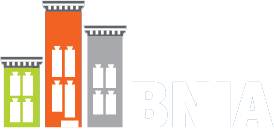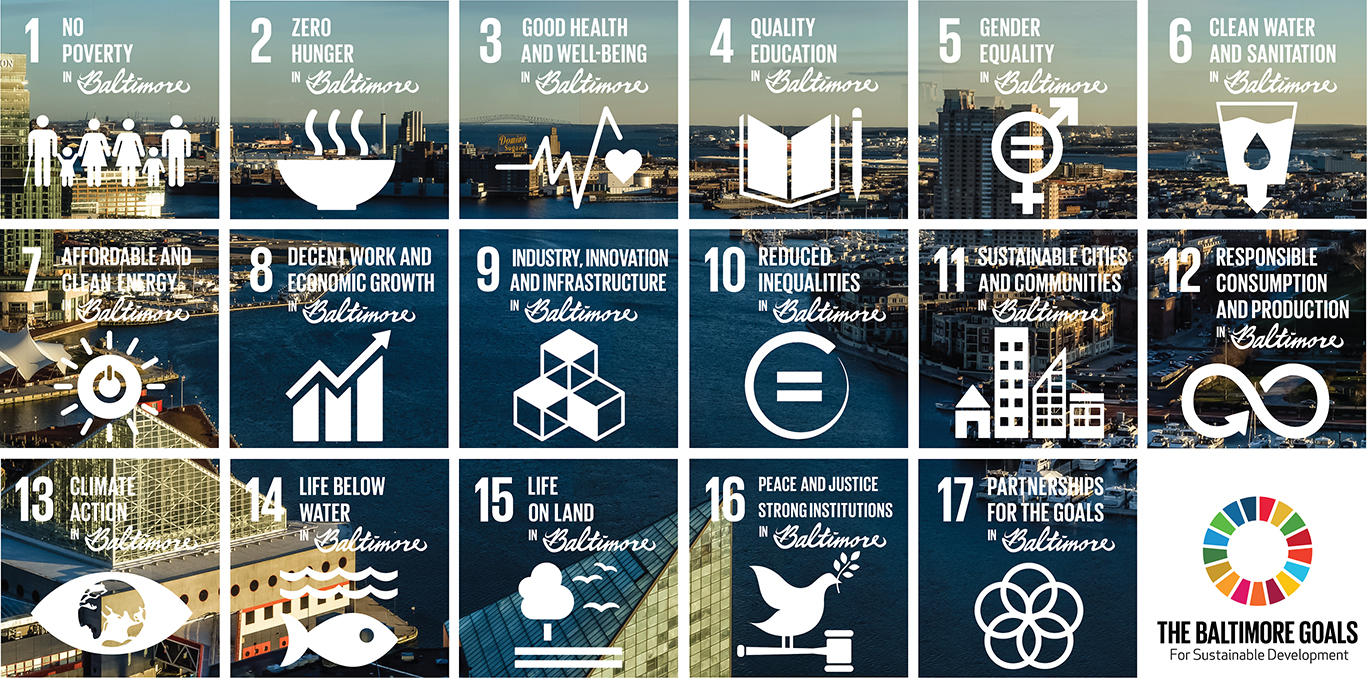In 2015, as part of a program called the USA Sustainable Cities Initiative (USA-SCI), Baltimore was selected as one of three US cities to pilot implementation of 17 new United Nations (UN) Sustainable Development Goals (SDGs). The SDGs, adopted by UN member countries in September 2015, form a cohesive and integrated package of global aspirations the world commits to achieving by 2030. They address the most pressing global challenges of our time, calling upon collaborative partnerships across and between countries and communities to achieve objectives around economic growth, environmental sustainability, and social inclusion. The final report, Baltimore’s Sustainable Future: Localizing the UN Sustainable Development Goals, Strategies and Indicators, articulates how the SDGs can be localized to support a more sustainable Baltimore.
The development of the report was led by the University of Baltimore’s College of Public Affairs and the Baltimore Neighborhood Indicators Alliance-Jacob France Institute in the University’s Merrick School of Business along with the University of Maryland National Center for Smart Growth and Communities without Boundaries International. Over the course of the year, the project was informed by a consultative group of Baltimore stakeholders who worked in collaboration with city agencies, community members, and other higher educational institutions to identify 54 concrete measures that track Baltimore’s progress towards each of these goals.
The process in Baltimore also revealed clear tasks that needed to be done in order to both access data currently not available as well as strategize on how the data can be deployed for all Baltimoreans to keep track of the indicator trends over time. With support from the Sustainable Development Solutions Network, the Baltimore Neighborhood Indicators Alliance prepared three issue briefs that help advance Baltimore’s foundation towards tracking the SDGs.
- Calculating the Percent of Households Earning a Living Wage to Monitor Progress for Achieving SDG #8: During the consultative process in Baltimore, stakeholders identified “Percent of Residents Earning a Living Wage” as a relevant indicator to set and track targets for SDG #8 (Decent Work and Economic Growth) in Baltimore. While the political support was there for the increase in the minimum wage, the percent of Baltimore’s population that was earning a living wage – which incorporates the household composition – had not been calculated for the City. Using a living wage methodology established by the Massachusetts Institute of Technology (MIT), the results show that households with two adults were far more likely to earn more than the living wage than households with only one adult. For 1-adult households with children the impacts are even more severe. Only 13% of 1-adult/1-child households earn more than the living wage; only 6.4% of 1-adult/2-children households earned more than the living wage. A key implication of this calculation is that any single minimum wage legislation would actually not achieve a living wage for everyone in all household types in Baltimore. In fact, the analysis shows that access to quality and affordable childcare, particularly for pre-school ages, for all household types would be worth campaigning for in Baltimore. This issue brief provides detailed technical guidelines for other cities to calculate the percent of residents earning a living wage.
- Finding Sustainable Data Sources to Track Evictions to Monitor Progress for Achieving SDG #16: Building consensus around what indicators to track for issues of peace and justice in Baltimore was a major part of the overall USA-SCI process. Finding data to track any proposed measures was an even more difficult challenge. Focusing on an important issue arising in Baltimore impacting low-income households and the legal justice system, this issue brief describes preliminary findings for reliable data sources for tracking Baltimore’s “rent court” statistics. Landlord-tenant disputes regarding failure-to-pay-rent cases (i.e. Rent Court) contribute to severe housing instability for an estimated 7,000 Baltimore households per year. Although shelter is a universal human right, for Baltimore’s approximately 50% of renter households, evictions, unaffordability, substandard housing conditions and other symptoms of housing insecurity contribute to poor outcomes in many other spheres of life such as health, employment and education. Data from an automated webscraping program called the Client Legal Utility Engine (CLUE) developed by the Maryland Volunteer Lawyers Service pulls of data from the Maryland Judiciary Case Search website, which contains information from the court dockets. The analysis shows that the CLUE program developed does provide a reliable way to obtain electronic data that could serve as the basis of an indicator tracking the rate of rent court cases in Baltimore over time. This issue brief cities several studies that point to the growing problem of evictions in US cities that disproportionately impacts vulnerable populations.
- Building a Local SDG Data Monitoring System for Baltimore: With the growth of open data portals at the local level, the question for Baltimore and other cities working to localize the SDGS is how feasible (in terms of cost and time) would it be to create a reporting platform that provides real-time, interactive data for stakeholders to locally monitor progress towards achieving the SDGs. In cities with advanced open data portals, like New York City, publishing to the open data portal is also largely dependent on the capacity of each city agency to upload and maintain the data. The National Reporting Platform for the SDGs, which is an open-source website with code available on GitHub for developers to potentially use for local reporting, is a welcomed advance for local jurisdictions to interactively track progress on the Global Goals. This issue brief details the kinds of staffing needs required by a local jurisdiction to both keep the open data portal maintained with relevant data to track SDGs and for the development of a local reporting platform. Ultimately, strong leadership and multi-sector collaboration is required to sustain this level of staffing and project coordination and, more importantly, to convene stakeholders to use the platform to work towards progress and monitoring of the SDGs.
In addition to these key steps towards implementing the SDGs in Baltimore, the Baltimore SCI team is working with the city’s Office of Sustainability to create a mapping of how the 54 localized indicators to track the SDGs relate to the new Sustainability Plan under development. To view the draft version of Baltimore’s Sustainability Plan, visit www.baltimoresustainability.org



